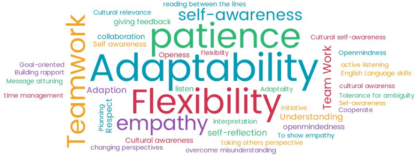Geen onderdeel van een categorie
How to integrate telecollaboration in a master programme? (Part II)
Through bi-weekly posts, MA staff participating in the USO-project on internationalisation will share concrete teaching tools and activities through which we aim to enhance ‘tailor-made’ internationalisation.
This week: <Telecollaboration Part II>: How telecollaboration promotes inclusive internationalisation and intercultural competence.
In part 1 of these two articles on telecollaboration, the structure of the pilot course is discussed. This second article focuses on the objectives of this pilot within the master Intercultural Communication with regards to internationalisation and intercultural competence.
Objectives
Internationalisation is increasingly promoted as a means to gain intercultural competence. The Strategic Plan formulates: “Students will have acquired international and intercultural skills to succeed in the highly globalised labour market” and adds the use of “innovative digital modes to teach students international and intercultural skills.”
Where intercultural skills are generally claimed to be best developed in real-life interaction, telecollaboration: “allows educators to engage their learners in regular, (semi-)authentic communication with members of other cultures in distant locations and also gives learners the opportunity to reflect on and learn from the outcomes of this intercultural exchange within the supportive and informed context of the classroom.” (O’Dowd, 2012).
O’Dowd (2012) differentiates between ‘intercultural contact’ and ‘intercultural learning’. To stimulate learning O’Dowd (2010) suggests three task levels which create situations where students do not merely (1) exchange personal and cultural information, but also (2) contrast and compare perspectives and (3) produce joint products (e.g. papers, presentations) with their international peers. In this telecollaboration pilot all tasks levels were included. Furthermore, students were continuously encouraged to reflect on their interactions during the tutorials and in a reflection blog as reflection is key to intercultural learning (Lough, 2010; Zhu, 2014).
A final objective of the course was to enhance digital literacies and to simulate international project work, as organisations increasingly work in virtual surroundings which presents challenges of its own.
More information on the structure of this project itself can be found in part 1.
Evaluation of the course
As one student noted in the course evaluation, the telecollaboration project was interesting because it meant: “Not only learning from theory but also experiencing the real situation to gain intercultural competences”. The collaboration was much more challenging than they expected: “You really experience the problems which can occur during such collaboration”. Most students believed they learned most from the continuous reflection: “What I really liked was reflecting because it helps you to look critically how you are doing and what you can do better next time.” What they learned was amongst others to be more adaptive, flexible and emphatic. They claimed to have improved intercultural and communication skills, including patience, listening, verifying and reaching understanding. The below word cloud shows which intercultural competences students felt they improved most during this course. Overall, they scored the course 3,8 on a 5-point Likert scale and there is definitely room for improvement which will now be discussed.

Suggestions for improvement
The teachers also learned much about telecollaboration. Despite timely preparations and agreements made in advance, the course was integrated and supervised differently in each institution (e.g. different deadlines and grading formats). Students found this a main downfall: “The students from other countries were graded totally different for exactly the same task which I don’t find very fair”. We learned that it’s crucial for all teachers to commit to mutual agreements as well as to shape the project together, as such creating ownership. In short: To first successfully telecollaborate themselves.
Assessment was also quite problematic as the final grade mainly covered the research paper and, what was unfortunately already indicated in Osiris, a theoretical exam. This theoretical focus was not in line with the learning goals. Most intercultural learning took place in the interactions and corresponding reflections, which only represented a very small percentage of the grade. Because of this, there was also little time to supervise their reflection process.
Although only three institutions were involved, the cultural diversity within some of the master programmes was much bigger resulting in very diverse groups. However, these groups were unequally balanced. Relatively, much more students from Utrecht participated resulting in teams where two students from Utrecht (mainly Dutch) would “interview” the student from the partner university. Most students maintained Dutch standards and repeatedly reported ‘having to take a leading role’ and provided feedback to their peers such as ‘this is all wrong, you have to rewrite everything’. Although this led to sometimes highly entertaining interactions and much self-awareness amongst Dutch students, this is not in line with the collaboration and learning objectives and for future collaborations balanced groups are key.
Keys to successful telecollaboration
Based on this interesting telecollaboration experience, I would suggest three important factors which can influence the success of telecollaboration:
- Partner(s): It is crucial for teachers of participating universities to mutually commit to and shape the project, as well as to make clear agreements on, for instance, grading and deadlines.
- Institutional support: Telecollaboration requires a serious investment of time for shaping the project and highly committed teachers, also able to support reflective learning and guide international group work and related obstacles.
- Aligning learning objectives and assessment: More accurate (formative) assessment of experiential learning is required, Programme designers should also revise their learning goals accordingly.
Conclusion
Although the pilot presented its challenges, students have learned much from the interactions and the corresponding reflections and indicated it did in fact enhance their intercultural competence. As such, this project demonstrates that with relatively little means, students can work together in international contexts, while working on different academic tasks and topics. It provides a clear example for the goal put forward in the Strategic Plan stating that innovative digital modes” will be used “to teach students international and intercultural skills”. Finally, telecollaboration offers a strong alternative to mobility and other more exhaustive forms of internationalisation, as it enables an international learning environment without actually having to leave home or the university, for any student.
Bibliography
Davis, N., & Cho, M. O. (2005). Intercultural competence for future leaders of educational technology and its evaluation. Interactive educational multimedia: IEM, (10), 1-22.
Kolb, D.A. (1984): Experiential learning: experience as the source of learning and development. Englewood Cliffs, NJ: Prentice Hall.
Lough, B. (2010) Predictors of intercultural competence among international volunteers. Electronic theses and dissertations, 214, Washington University
O’Dowd, R. (2012). Intercultural communicative competence through telecollaboration. In Jackson, J. (Ed.) The Routledge Handbook of Language and Intercultural Communication. New York: Routledge.
Strategic Plan Utrecht University (2016-2020): https://www.uu.nl/sites/default/files/ubd_strategic_plan_utrecht_university_2016-2020.pdf
Zhu Hua (2014). Exploring Intercultural Communication. Language in Action: Routledge.
 19 april 2017
19 april 2017
U moet ingelogd zijn om te reageren, gebruik het formulier aan de linkerkant om in te loggen met uw solis gegevens.


